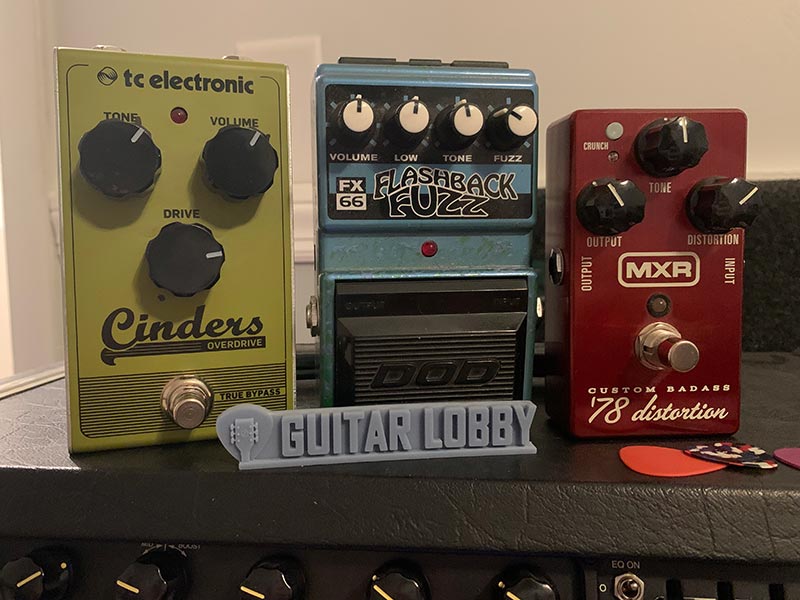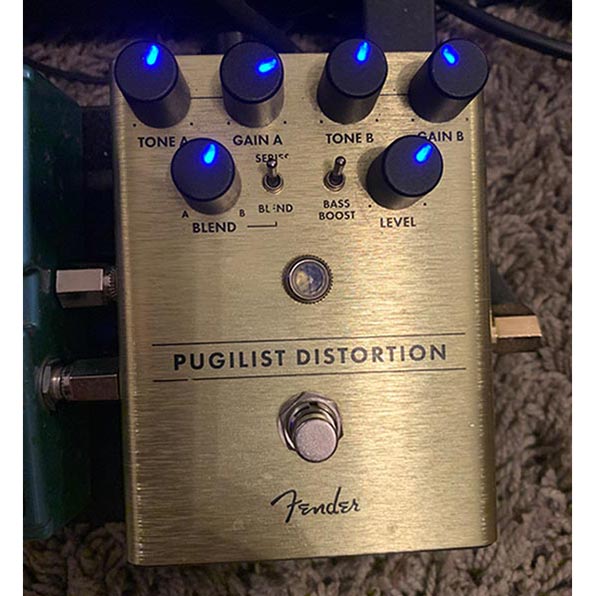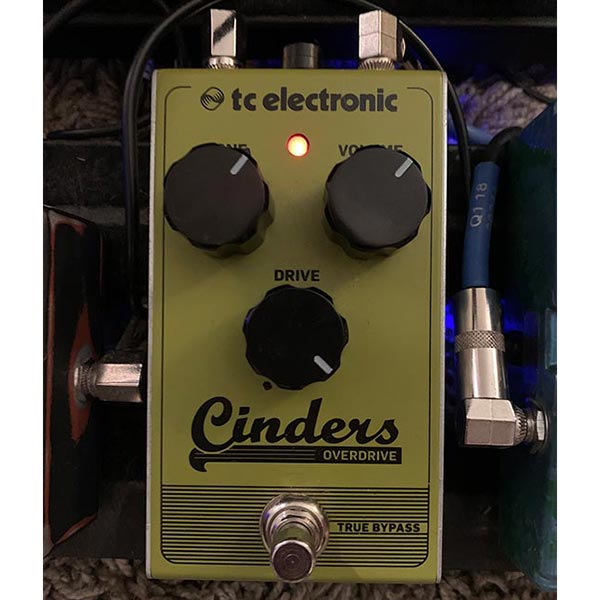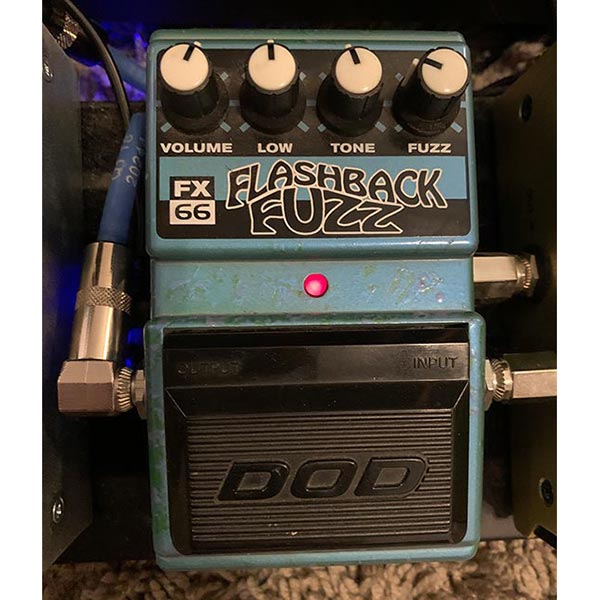The electric guitar was originally used to produce bright and clean tones by jazz musicians. Distortion was seen as something to be avoided in those formative years, but the advent of rock and blues in the 1950s marked a change in attitude towards distortion as an effect.

Fast forward to the present day, and distortion, overdrive, and fuzz are three of the most heavily used effects by guitarists and other musicians. Musical styles have been created largely as a result of these three effects, and there is a wide array of pedals out there that produce them.
If you’re unfamiliar with the key differences between distortion, overdrive, and fuzz, choosing the right effects for your requirements can be tricky.
In this guide, we’ll compare distortion vs overdrive vs fuzz pedals. After comparing these three gain-based effects and explain how you can use them to enhance your performances or recordings.
The Basics of Distortion
The term distortion is used in many different ways in musical and sonic contexts. Decades ago, it was seen as something to be avoided at all costs. Unintentional distortion had the power to completely ruin a recording when analog equipment was the norm.
Simply put, distortion occurs when the volume level of a sound surpasses the level that a certain device is able to handle. This could be a piece of hardware, or in the digital era, it could be the input on an audio interface.
In the modern era of guitar playing and music production, distortion is seen as a desirable effect that has been used on countless recordings. Some would argue that entire musical genres have been created as a result of distortion and the sounds it produces.
Before we get into the specifics of distortion and compare it to overdrive and fuzz, it’s important to note that in the world of effect, distortion is seen as a separate entity from its two counterparts. Technically speaking, overdrive and fuzz are variations of distortion, but when discussing guitar pedals there are many key differences between the trio.
The Basics of Overdrive
Overdrive is a form of distortion which is literally caused by a guitar amplifier being driven over its dynamic limits. It was first produced when rock guitarists noticed that maxing out their tube amps produced warm saturation.
Most guitarists agree that the best-sounding overdrive comes from a tube amplifier with the gain cranked up high, but many brilliant pedals can be used to produce this effect.
In terms of effects pedals, overdrive is significantly less intense than distortion. It injects warmth into a guitar’s output, without causing the same level of clipping that a distortion pedal does. This makes overdrive a great tool for musicians across a wide range of genres and styles.
The Basics of Fuzz
Fuzz is a special variety of distortion. Its effect is very distinctive and transformative because it adds harmonic overtones to the signal.
The difference between fuzz and overdrive is that the former focuses mainly on the higher frequencies of a sound, while the latter targets the whole frequency range in a more general manner. Fuzz is therefore used for solos and riffs which need to cut through the mix.
There are many highly capable fuzz pedals on the market, some of which have been available since the early days of rock n’ roll guitar.
The Dynamic Differences Between Distortion, Overdrive & Fuzz
One of the key areas where distortion, overdrive, and fuzz differ from one another is in their impact on the dynamics of an instrument. Each of these effects adds gain to the signal, which causes an increase in volume. However, this boost varies in terms of its extremeness.
Distortion & Dynamics

Distortion causes the signal of an electric guitar or another instrument to become a square wave. Those who have experience in the recording will most likely have seen an audio waveform with distortion applied to it, which makes it look like a square block rather than a random pattern of peaks and troughs.
This causes the dynamics of the guitar to become more like a singular block, which reduces the diversity of the volume. When a waveform is composed of many different spikes and curves, this signifies that the volume isn’t constant and is constantly fluctuating.
When a guitarist stomps on their distortion pedal, the signal of their instrument is thickened and squared off at the edges, which creates a wall of sound. In that respect, a distortion pedal acts similarly to a compressor, except it also adds gain to the signal along with reducing its dynamic range.
Overdrive & Dynamics

The impact that overdrive has on the dynamics of a sound source is less intense than distortion. Overdrive uses soft clipping, which increases the gain of the signal without creating the solid square block that distortion results in.
When using an overdrive pedal or achieving the effect by cranking a tube amp’s gain, there will be an inevitable increase in the overall volume, but more dynamic diversity will be present than when distortion or fuzz is applied.
This is why many guitarists prefer to use overdrive for additional gain. It adds power and color to the signal but doesn’t completely obliterate the control the musician has over the volume and dynamic range of their instrument.
Fuzz & Dynamics

The effect that fuzz has on dynamics is similar in some ways to distortion, in that they also cause the signal to become a square wave, reducing the range of volume noticeably.
Nevertheless, there is one key difference between fuzz and distortion in this respect. Fuzz has the ability to increase the sustain of a sound significantly, causing it to remain dynamically consistent for longer than distortion or overdrive is capable of.
Like distortion, fuzz reduces the amount of control that a musician has over the dynamic range of their instrument. If you were to crank up the settings on a fuzz pedal and play a note, it wouldn’t matter too much how hard you played – the dynamics would be consistent and significantly louder than if you played on a clean setting.
Tonal Differences Between Distortion, Overdrive & Fuzz
In addition to the impact these three effects have on the dynamics of an audio signal, they also transform it tonally.
It’s arguably easier to identify distortion, overdrive, and fuzz based on the tone-altering effects they produce than it is based on their impact on volume and dynamics. Again, there are some similarities between the three, but when we take a closer look, the differences become clear.
Distorted Tone
The tone of distortion can be summarized in one word – aggression. Whether you’re using a distortion pedal for guitar or applying the effect within recording software, the sound will be subjected to a considerable amount of saturation.
Every distortion pedal has its unique EQ settings which determine the overall coloration and character that they produce. Heavy distortion pedals designed for hard rock and metal guitarists may target the whole frequency spectrum of a guitar, while others may predominantly distort the mid-range or treble frequencies.
Overdriven Tone
By comparison, overdrive produces a more musical tone than distortion. This is partly because overdrive leaves you in control of the amount of saturation that is applied to the signal, based on the velocity of your playing or the loudness of the original signal.
Whilst distortion and fuzz tend to sound gritty and grungey, overdrive highlights the prominent frequencies of a guitar or other instrument and adds warm, creamy overtones to them.
Overdrive pedals can be used with either lead or rhythm guitar pieces. The soft clipping doesn’t cause groups of notes to become overly messy, whereas distortion or fuzz turns a chord into a block of saturated sound with very little definition between the individual notes.
Fuzzy Tone
When fuzz is applied to a guitar or other instrument, it creates a face-melting effect! Tonally, fuzz targets the mid and higher frequencies more aggressively than it does the bass frequencies. The result is that the low-end is still quite clear when the effect is applied.
By heavily saturating the upper frequencies of a guitar’s signal, fuzz is an effective tool for ensuring that a solo or riff manages to emerge from the rest of the mix and be heard over drums, bass, and rhythm guitar.
The key difference between fuzz and distortion is that the former has a slightly more musical tone, whilst the latter creates a solid block of sound with very little tonal variation.
Styles & Genres
The beauty of these three distortion-based effects is that they can be used across a wide range of styles and genres, and can also be applied to many different instruments. However, despite their versatility, there are some styles for which the effects have been heavily used in the past by musicians.
Metal Distortion
One genre with which distortion is intrinsically linked is metal. It could be argued that without distortion the whole style of metal guitar simply would not have come into existence.
The chugging, palm-muted style of rhythm guitar which is often sound in metal and hard rock uses heavy distortion to ensure consistent dynamics and plenty of attitudes. The reason that distortion is preferred for metal over fuzz and overdrive is that it remains at one volume throughout regardless of playing velocity.
Distortion is also a useful tool for playing low-end riffs. Some pedals are set up with an EQ that focuses on the lower-end of a guitar’s frequency range, which makes them ideal for the powerful and technical riffs found in heavy rock and metal.
Overdrive & Blues
Each of the three effects is used in the genre of blues, but the most heavily used form of distortion in this style is overdrive. Blues guitar requires the player to control both the dynamics and the tonal aspects of their playing, and overdrive is the perfect effect for achieving this.
In heavy blues, there are likely to be moments when using fuzz or distortion for a solo would be more appropriate than overdrive. Nevertheless, overdrive allows the guitarist to switch between rhythm and lead seamlessly without creating a muddy mess.
Blues guitarists often use tube amplifiers to produce overdrive. They may even combine an overdrive pedal with a tube amp, and use the effect as a trigger to push their valves to their limits and create those highly sought-after tube breakups.
60’s Fuzz
Fuzz pedals were first popularized in the 1960s by rock guitarists like Jimi Hendrix and Eric Clapton. They’ve become synonymous with the classic rock n’ roll guitar tones that defined that era.
Fuzzy riffs were also used by British Invasion bands in the 1960s, like The Kinks, The Who, The Rolling Stones, and The Beatles. The effect was used to make the riffs sound more colorful, and create contrast between the stereotypically clean rhythm guitar sounds.
Hendrix’s fuzzy wah tone is regarded as one of the most iconic uses of the effect. Today, many psych-rock revivalists use fuzz to recreate the tones from the golden age of rock n’ roll guitar playing.
Tube Amp Overdrive
Fuzz and distortion are two very popular effects used by musicians and producers, but overdrive is arguably the most common.
The discovery of how overdrive was discovered and was subsequently transformed into a desirable effect marks a significant point in the field of gain-based processing. Let’s take a look at exactly how this variety of overdrive is produced.
How Tube Saturation Works
Although overdrive is now seen as a desirable effect by musicians, it originated as a result of a mishap. The limitations of tubes that have been used in guitar amplifiers for over half a century led to the discovery of the overdriven sound.
Amplifiers have preamp and power tubes, both of which perform a vital function in producing the sound of an electric guitar or another instrument. When the voltage of these tubes increases to their maximum capacity, the signal begins to clip. Clipping causes parts of the waveform to be cut off, due to the voltage-handling limitations of the tube.
When the tubes are pushed beyond their limit, overdrive is produced. This causes the sound to become saturated, with increased warmth and presence. The more the gain is increased, the more prominent the overdrive becomes.
That’s where the word ‘overdrive’ comes from. The guitarist’s signal is being driven through the valve within the amplifier, which consequently results in clipping and saturation at the peaks of the signal’s waveform.
Turning Up The Heat
Interestingly, the process of overdriving a guitar amplifier is a result of an increase in temperature. You’ve probably heard guitar tones being described as ‘hot’ or ‘warm’ when overdrive is applied. These words are used because the saturation occurs as a physical reaction of the tubes heating up due to the voltage they receive being increased to the point where they can no longer handle it.
This is the same as when any electronic item is used for a long time or plugged into a power supply that provides more voltage than the item requires. Inevitably, the item will become hot, and this can sometimes result in damage to the circuitry.
However, heating a tube within a guitar amplifier won’t damage the internal components. It will cause the tubes to wear out more quickly, which is why they need replacing periodically as anyone who uses a tube amplifier will know from experience!
Without getting overly technical, the reason that the tubes being heated causes an overdriven guitar tone is because the increased temperature causes the non-linear movement of electrons and the audio signal. Amplifier manufacturers may install certain mechanisms to control the amount of voltage each tube is subjected to, thus shaping the overdrive that is produced.
Overdrive vs Distortion Pedals
Thanks to the invention of effects stompboxes, guitarists don’t need to invest in a bulky tube amplifier to gain access to warm overdriven tones. Many early pedal designers took inspiration from the sounds made by their amplifiers when creating overdrive pedals.
Klon Centaur Circuit
The Klon Centaur circuit, which is widely regarded as a hugely innovative creation, was based on the tone that the creator, Bill Finnegan, achieved when cranking the gain on his Fender Deluxe Reverb amplifier.
The issue with using the amplifier to produce overdrive was that Finnegan had to crank the volume so loud that it wasn’t practical for most settings and environments. As a result, he set out to recreate the warm saturated tone in a pedal form, so that it could be produced at much lower volumes and would therefore be accessible to all musicians.
Tonal purists would argue that even the finest overdrive pedals don’t quite capture the essence of a heated tube within an amplifier. However, these devices make it possible for guitarists to access overdrive without needing to damage their hearing or cause disturbance to their neighbors.
Gain Stage
Overdrive pedals are versatile and are often used as an additional gain stage before the signal reaches the amplifier. This is similar to adding another tube to the amplifier’s circuit, increasing its capacity for producing saturation.
For this reason, most overdrive pedals are designed with a significant amount of output headroom. The additional headroom allows the guitarist to push harder into the front end of their amplifier, effectively pounding the first preamp tube with more aggression to create a hotter tone.
Distortion Pedals
Distortion pedals differ from overdrive pedals in that they are generally used as standalone devices. Overdrive leaves some room for additional gain to be applied to the signal, while distortion adds high amounts of gain initially so using it with other gain-boosting effects would be less impactful.
Like fuzz pedals, distortion increases the sustain of notes and chords when it is applied to a guitar’s signal. The noise floor is raised, which prevents the volume of certain notes from getting drowned out during the process of saturation.
Compatibility With Other Effects
Choosing between distortion, overdrive, and fuzz pedals requires you to consider their compatibility with the other effects in your signal chain. Although this is largely a subjective matter, using a certain combination of pedals will allow you to create your tone more deliberately.
Distortion & Other Pedals
Distortion pedals possess the ability to add large amounts of gain to your signal, creating a powerful and penetrating tone. There’s no denying the benefits of this effect, but one potential tradeoff is that it can cause the dynamic of a guitar to become a little unpredictable.
Therefore, pairing a distortion pedal with a good compressor is a wise move. Compressor pedals reduce the dynamic range of the guitar’s signal, limiting the volume of any notes which exceed the threshold, and boosting any notes which fall below it.
Likewise, volume pedals are useful when paired with distortion. Although an increase in volume may be desirable in certain situations, sudden spikes can cause problems when performing. Due to the increased gain that distortion pedals produce, it may be necessary to use a volume pedal to control the dynamics and make the levels more consistent with the rest of your effects in the signal chain.
Overdrive & Other Pedals
Overdrive pedals are less intense than distortion pedals, which makes them even more compatible with a range of other effects. You can use an overdrive pedal with any modulation effect providing you don’t crank up the gain too much. Overdrive simply makes modulation effects sound warmer and more powerful.
Many guitarists choose to leave their overdrive pedals on at all times, to add color to their tone. Reverb and delays pedals sound great when combined with overdrive due to the blend of slight saturation and timing alterations.
Fuzz & Other Pedals
Although fuzz pedals are harder to tame than overdrive pedals, they are still highly compatible with other popular effects. One common pedal which is often combined with fuzz is wah-wah. This was popularized by Jimi Hendrix, who utilized the Fuzz Face with a Cry Baby wah pedal.
Fuzz also blends nicely with many modulation effects, notably octave shifters. The warm saturation applied to a guitar interacts seamlessly with the higher and lower octaves that these pedals add to the output.
Distortion vs. Overdrive vs. Fuzz – Other Instruments & Vocals
Although distortion, overdrive, and fuzz are most popularly used with electric guitar, many musicians utilize these effects with other instruments. Many singers also use these effects to add a gritty, rough tone to their vocals.
Bass Guitar
Bass guitars are tuned an octave lower than electric guitars in standard tuning, and their strings are usually significantly thicker. This is what gives the instrument its deep, powerful tone.
The prominent low-end of a bass guitar works incredibly well with distortion, overdrive, and fuzz. Some would argue that it is more compatible with this trio of effects than a 6-string electric guitar is.
Of the three effects in question, distortion is the least compatible with bass guitar. This is due to the extreme saturation it causes, which can cause the low-end frequencies of the bass to become overly muddy.
Overdrive is highly effective with used with a bass guitar. It provides warm coloration in the mid and higher tones of the instrument, whilst refraining from obliterating the low-end notes, as is often the case with distortion.
There are also many bass-specific fuzz pedals on the market which transform the output into a saturated fireball. Electro-Harmonix’s Bass Big Muff is a good example of this and is used by many bassists to add fuzzy overtones to their signal.
Keyboards & Synths
In electronic music, distortion is commonly used with synthesizers. In live settings, this may be achieved by connecting the synth or keyboard to an effects pedal. In the studio, it’s more common for producers to use VST plugins.
Synth sounds are very malleable and are therefore compatible with distortion, overdrive, and fuzz. These combinations create powerful sounds which can be used texturally or as a prominent part of a production, such as a lead synth or melody line.
Drums
As musicians and producers have moved away from the traditional methods of processing instrument recordings, which mainly involved using outboard gear, it’s become more common to hear drums mixed with distortion.
Adding saturation to a drum kit increases the prominence of certain transients, thus adding a powerful element to the overall sound. VST plugins allow mixing engineers to be very specific with the amount of distortion that is added to each drum to achieve their desired effect.
Drum samples are also commonly used with overdrive and distortion plugins. Fuzz is perhaps less compatible with percussion, as this can cause the transients to sound harsh on the ear. When used sparingly, distortion is a great way to make a dry drum sample sound warmer and more characterful.
Vocals
In addition to the aforementioned instruments, distortion, overdrive, and fuzz can also be applied to vocals. Genres such as punk and garage rock popularized the “megaphone” vocal effect, where distortion is used to create a rougher sounding vocal.
There are many vocal distortion pedals available that allow singers to recreate this effect in a live setting. One common issue when applying distortion to vocals is feedback – but this can be combated using a feedback suppression pedal. Some vocalists may also use tube amplifiers to create a saturated tone when performing live, but again this can easily lead to noise issues.
There’s no limit to the amount of saturation that can be added to a vocal track. Fuzz creates extreme distortion which makes the lyrics almost inaudible, whilst overdrive adds a less intense amount of gain to the singer’s voice.
Wrap Up
Understanding the differences between distortion, overdrive, and fuzz is vital if you want to deliberately shape the tone of your guitar or apply the best-suited effects to your recordings.
If you’re a metal musician looking to create powerful, red-hot tones, then the distortion is the effect you’re looking for. In pedal form, distortion is an instant way to ramp up the gain of a guitar and push it into extreme saturation.
Overdrive on the other hand is better suited to those who want to retain some of the sonic and tonal aspects of their instrument’s clean sound, but also have the power to push it into the territory of warm breaks up and slight distortion.
Finally, fuzz is the most extreme form of clipping that can be applied to a signal. This effect is designed to obliterate the tonal aspects of the sound source, and transform it into a powerful blend of muffled distortion and unpredictable tonality.

My name is Chris and I’ve had a passion for music and guitars for as long as I can remember. I started this website with some of my friends who are musicians, music teachers, gear heads, and music enthusiasts so we could provide high-quality guitar and music-related content.
I’ve been playing guitar since I was 13 years old and am an avid collector. Amps, pedals, guitars, bass, drums, microphones, studio, and recording gear, I love it all.
I was born and raised in Western Pennsylvania. My background is in Electrical Engineering, earning a Bachelor’s degree from Youngstown State University. With my engineering experience, I’ve developed as a designer of guitar amplifiers and effects. A true passion of mine, I’ve designed, built, and repaired a wide range of guitar amps and electronics. Here at the Guitar Lobby, our aim is to share our passion for Music and gear with the rest of the music community.
